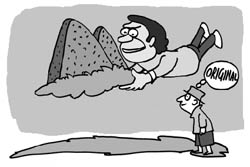Branding from origin
 the Indian system of medicines can take a leaf out of the French experience when it comes to marketing their products. Geographically labelling the medicinal plants used in various preparations, which shows their source of origin, would translate into better business. Not only would it put a seal of genuineness but adulteration can also be prevented.
the Indian system of medicines can take a leaf out of the French experience when it comes to marketing their products. Geographically labelling the medicinal plants used in various preparations, which shows their source of origin, would translate into better business. Not only would it put a seal of genuineness but adulteration can also be prevented.
Currently, it is not compulsory, according to Indian law, to show source of origin of plants, whether collected or cultivated, when they are marketed. Confusion may arise as one can never be sure that what is supplied is, say, genuine Ashwaganda and not a Californian cousin, intrinsically different and economically a large-scale competitor.
With a rapidly growing domestic and world demand putting greater pressure on supply of medicinal plants, over-exploitation of natural resources, bad harvesting and destruction of habitat are bound to follow. Cultivation of medicinal plants may appear as a sound alternative to gathering in the wild if not the only way out. But for that region-specific plants must be grown and collected, providing they are recognised in the market.
This concept has been successfully put to practice in France for decades now. Since the 1920s, a policy of origin labelling of agricultural products, with a double goal of specificity recognition based on area, process, culture, and product differentiation has been benefiting small-scale producers.
The bargaining power
In the industrial world monopolistic bargaining power is commonly achieved through trademark. But this is not possible when the economy is small as in the case of the agriculture sector the world over. Here comes the advantage of geographically labelling products. Food or agricultural products with specific characteristics are linked to their area of production and this recognition of origin has been a way of branding the product. Origin labelling will then avoid usurpation of name.
The semi-arid mountains of southern France has been famous for its lavender over the centuries for its extensive use in aromatherapy. The essential oil produced from the flower is a vital ingredient in many cosmetics. The specifications of the label stress that oil must come out of Lavanda angustifolia P Miller, and seedlings must be of local origin. Local here means a strictly recognised area of production.
Same is the case with French wines. Ever since 1919, the label of the wines implies a strong link between product and the site of origin, the geographical name expresses the imprint of the lace, and therefore the specificity of the product. Unlike industrial standardisation, origin labelling is recognition of typicality; something unique to one particular region and which cannot be reproduced anywhere else.
The central plains of France have raised dairy cattle for centuries. The region, wet enough to be covered with meadows, is around a small town called Chaource. A particular cheese that is produced in this region is well known. People believe monks of a nearby monastery originally produced it. This home-made milk product is soft, sweet and slightly sour
